TALES OF MY FATHER
 My Father ……. Jack-of-all-Trades, Master-of-None ……. an enigma
My Father ……. Jack-of-all-Trades, Master-of-None ……. an enigma
-oOo-
TALE EIGHT:
LIFE AT R. COOKE & SON
5 CAMBRIDGE HEATH ROAD, STEPNEY
LONDON E.1.
UNFORTUNATELY I HAVE NOT BEEN ABLE TO FIND A PHOTOGRAPH OF THE SHOP
-oOo-
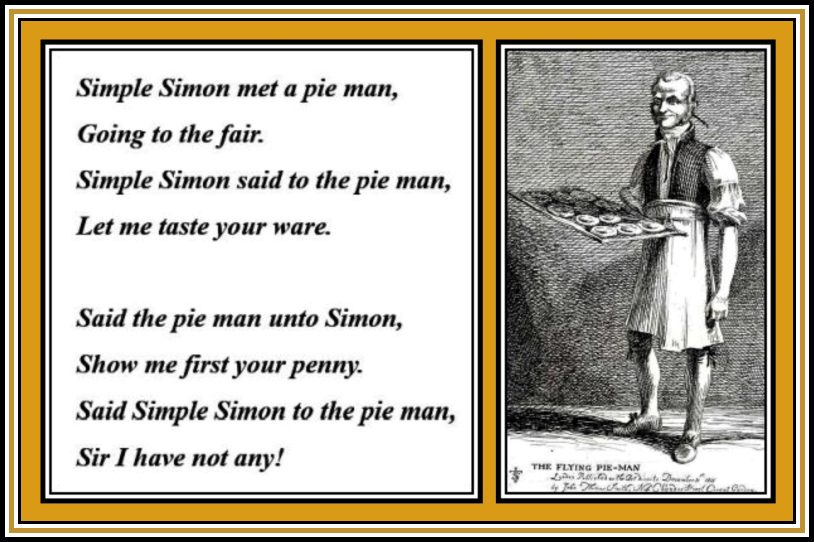 Simple Simon & The Pie Man
Simple Simon & The Pie Man
-oOo-
Allow me to discuss firstly my father’s duties at Cooke’s:
Generally the day began between 4.30 and 5.00 a.m. when he had to rake out the old-fashioned furnace adjacent to the huge oven where the pies were to bake, and on top of which, the eels and potatoes were to cook. All foods were prepared daily and had to be ready for sale when the shop opened each day, Monday to Saturday, at 11 a.m.
In addition to the preparation of food, there were various Sundry Jobs that had to be completed before the shop opened for business. These will be dealt with later.
-oOo-
Food was prepared in a large Bake House with a very high ceiling complete with a fan light and was found at the back of the shop. It was equipped with a number of devices used to help prepare the delicacies to be sold by my mother at the front of the shop.
These devices included:
- a large steel machine where the dough for the pies was mixed. The machine consisted of a huge drum that rotated in one direction while mixing knives rotated in another. In addition, the machine was equipped with a large slicer that lifted and was used to chop off pieces of dough, as needed. The slicer could be maintained in an upright position, but my father avoided doing this, since it had fallen back into its normal resting horizontal position without warning on several occasions. I was forbidden to go near this device, and believe me, I did not need to be reminded, as I found its action quite terrifying as a child;
- a large space next to the mixer/slicer where the dough was rolled out and cut to fit individual little baking tins;
- part of this space also held a cutting board where the eels were prepared for cooking;
- another area of this space contained a device in which potatoes were crushed and pushed through a series of holes before having liquid added in order to convert it into mash;
- a huge and deep sink where the large pots and other equipment were washed together with a long draining board; and finally
- the coal-burning furnace complete with a large oven where the pies were baked and on top of which huge saucepans were placed for the cooking of eels, boiling of potatoes and preparing the liquor.
SUNDRY DUTIES:
- Putting fresh sawdust down on the shop floor twice daily;
- Sweeping the sawdust up twice daily after the shop closed at 3 p.m. and after 11 p.m.; and
- Scrubbing the shop’s wooden floor each Sunday morning for which he received five shillings (i.e., 25 pence in todays money).
-oOo-
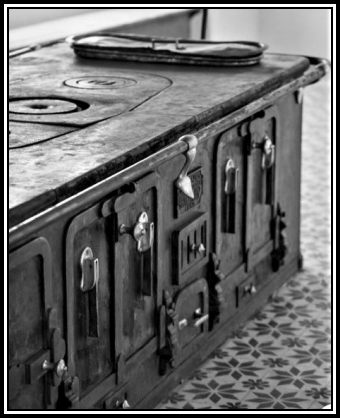 Unfortunately, this is not a photograph of the furnace used by my father,
Unfortunately, this is not a photograph of the furnace used by my father,
but is the nearest looking one that I have been able to find
The furnace was to prove to be the BANE of my father’s life since he soon discovered that in order for it to function and allow baking and cooking each day, it needed to be kept alight over nigh! He found out that if the fire died out then it would take an age to restart it! Starting the fire always proved a difficult job and often took between two or three hours and several days to restart! The longest period of inactivity occurred on the days following Bank Holidays when the owners insisted that they could not afford to continue burning coal without baking! Their excuse was that coal was expensive. However the company lost more money from the days when the shop could not open! Allowing the fire to go out over a Bank Holiday, in general, meant that the oven did not function before the following Wednesday! That meant two days of lost revenue and the loss of much customer goodwill!
-oOo-
My father was a master at making pies. Individual pies were made in small pie dishes that had been placed on huge trays, which were slipped into the oven. I believe that he was able to bake three trays each containing twenty pies.
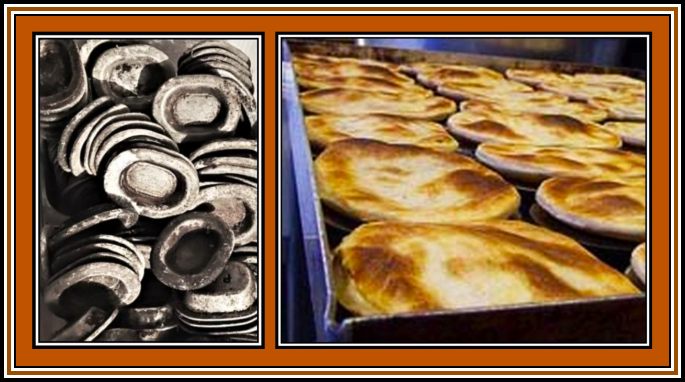 Left: Individual Pie Dishes; Right: Baked Pies on a Tray
Left: Individual Pie Dishes; Right: Baked Pies on a Tray
When baked, the pie crusts were flaky, dark golden brown, and not only looked wonderful, but also melted in the mouth! The baked pies would be carried into the shop and transferred to a long heater where they were kept warm for customers. My father’s pies never remained long in the heater, as they were very popular with customers and were quickly gobbled up in the shop or taken home.
I have to admit that they were delicious. I have visited many Pie Shops over the years, both in the U.K. and in Australia (where they appreciate a good pie, unlike Europeans and North Americans!), and although their wares were good, I never a pie to compare with those baked by my father.
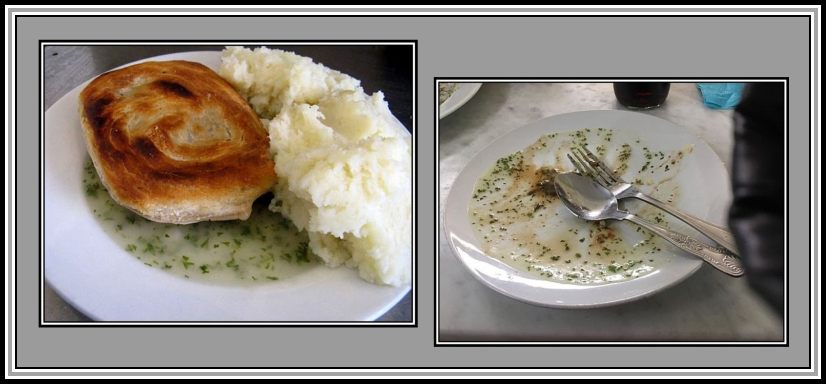 Pies were eaten with a Fork & Spoon – never with a Knife
Pies were eaten with a Fork & Spoon – never with a Knife
I remember that my mother telling me that knives were too dangerous to give to some customers since this was the East End! Whether this was/is true, I do not know, but knowing the area when I was a kid (and today!), I can believe it!
-oOo-
My father also cooked peeled potatoes on the furnace top and then pushed them through a Masher or Smasher, as it was commonly called. He also prepared the Parsley Liquor, which was made at that time with the addition of a colouring agent. I never liked the Liquor and so paid no attention to how it was made!
-oOo-
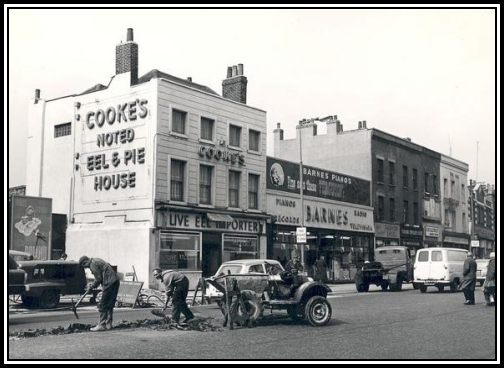 The Stratford Branch of Cooke’s (now demolished)
The Stratford Branch of Cooke’s (now demolished)
Very early each morning, George, the manager of the Stratford Branch of Cooke’s, would travel to Billingsgate Fish Market in the City of London in order to collect Eels for preparation and sale in Cooke’s shops. George would deliver a wooden tray containing the slow moving live Eels for my father to prepare for sale to an awaiting public. (Note: Today, Eels are maintained in metal trays – see the Collage that follows.)
-oOo-
The Eel is a Catadromous fish …….. this means that it is a fish that spends most of its life in fresh water and then migrates to the sea to breed. The Eel of the genus Anguilla, numbering sixteen species, including the North American (A. rostrata) and the European Eel (A. anguilla). These Eels spawn in warm saline waters of the Atlantic Ocean, at depths of 400 to 700 metres (about 1,300 to 2,300 feet), in an area centred near Latitude 26° N Longitude 55° W known as the Sargasso Sea.
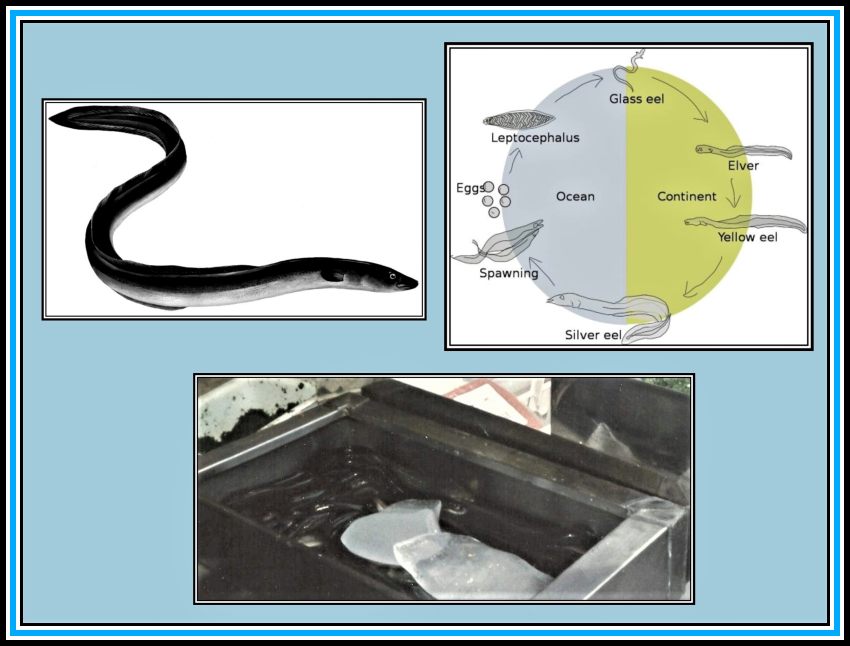 The Eel – Genus
The Eel – Genus
Top Left: The Eel; Top Right: Life Cycle; Bottom: A Tray of Eels ready for preparation
The eggs develop into Leptocephali, which are transparent, leaflike forms and are carried by the Gulf Stream to the shallow waters of the continental shelves. One they reach two and one-half years old and about eight centimetres long, they metamorphose into so-called Elvers, which are bottom-dwelling, pigmented, and cylindrical in form. In spring, once they arrive in coastal waters as Glass Eels, they swim upstream in freshwater streams. The young fish gather by millions, forming a dense mass several miles long. In freshwater, they grow to full size, becoming yellow eels. They live as such for ten to fifteen years before changing into Silver Eels and swimming downstream to the sea and return to the spawning grounds and die.
The Genus consists of elongated fish with no Pelvic Fins. Their Dorsal and Anal Fins are fused with the Caudal Fin and form a single fin running along much of the length of the animal.

-oOo-
Eels are slippery creatures and difficult to grasp, as they have a mucus coating. My father knew the technique to hold them firmly so that he could decapitate them and chop off the tip of their tails. Following this, he would next make a long slit along the underside of their bellies and then scrape out the guts and other organs. Once the carcass was de-gutted, it would be chopped into pieces of suitable size for cooking and consuming. The pieces would then be washed and placed in water being heated on the furnace and allowed to cook until tender.
The liquid that the Eels were cooked in (i.e., water with a little salt added) was retained and added to a bowl along with the Eel pieces and carried out to the shop for sale. Some customers, including me, would prefer to have their dish served with this Liquor (rather than the green parsley variety), and was known as Their Own Liquor. However, as a child, I always miss-heard this and thought that it was called ‘N-rown-liquor! I didn’t realise my mistake until years later!
Some of the cooked Eel pieces together with Their Own Liquor were allowed to cool to room temperature, taken down to the cellar and placed in the large refrigerator. Here the Liquor would set to form a jelly, thereby producing Jellied Eels.
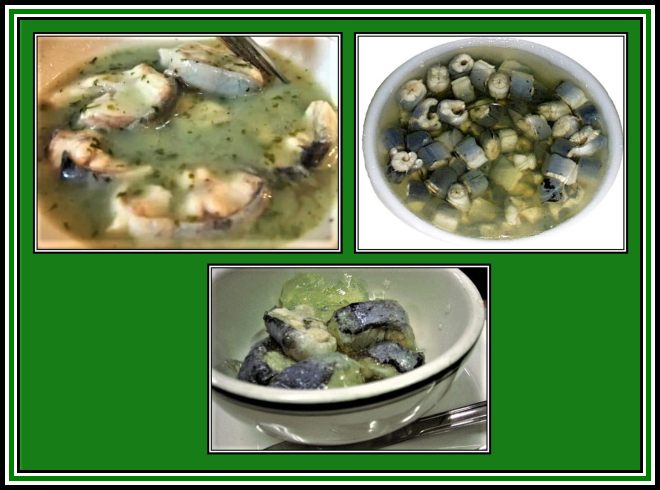 Left: A portion of Hot Eels served with Parsley Liquor; Right: Bowl of Jellied Eels;
Left: A portion of Hot Eels served with Parsley Liquor; Right: Bowl of Jellied Eels;
Bottom: A portion of Jellied Eels ready for sale
-oOo-
My father brought out the baked pies and cooked eels, mashed (smashed) potatoes and liquor out to my mother for sale throughout the hours of shop operation. During the preparation, he had to clean the pots, pie trays etc that he had used.
Once the shop closed at 3 p.m. following the lunch session, he would sweep the shop out and put down fresh sawdust for the evening seance. In those days, people were in the habit of dropping all kinds of things on the ground and also stubbing their cigarettes out there – it is amazing that we never had any fires! – and they also enjoyed spitting wherever they chose!!!
After this, he ate something which my mother had cooked upstairs in the flat and then would collapse on the bed for a short nap before getting up to open the shop at 5 p.m. for the dinner rush.
-oOo-
Now if you think my father worked hard – which he did! – read on and read about my mother’s working life at Cooke’s!
-oOo-
My parents ran Cooke’s at 5 Cambridge Heath Road until 1956. Sadly FOR US, the ending of the relationship with the Cooke Family was not pleasant, but more of that later!
—oooOOOooo—
-oooOOOOooo-
-oooOOOOooo-
-oooOOOOooo-
